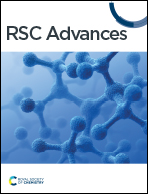Integration of network pharmacology, molecular docking, and simulations to evaluate phytochemicals from Drymaria cordata against cervical cancer†
Abstract
Introduction: Cervical cancer is prevalent among women worldwide. It is a type of cancer that occurs in the cells of the cervix, the lower part of the uterus. Mostly, it is observed in developing nations due to limited access to screening tools. Natural products with anticancer properties and fewer side effects have gained attention. Therefore, this study evaluates the potential of Drymaria cordata as a natural source for treating cervical cancer. Methodology: Phytocompounds present in Drymaria cordata were screened for their molecular properties and drug-likeness. The selected compounds were studied using systems biology tools such as network pharmacology, molecular docking, and molecular dynamics simulations, including MMGBSA studies. Results: Through network pharmacology, molecular docking, and molecular dynamics simulations, quercetin 3-O-β-D-glucopyranosyl-(1→2)-rhamnopyranoside was identified as a hit compound targeting HRAS and VEGFA proteins. These proteins were found to be responsible for the maximum number of pathway modulations in cervical cancer. Conclusion: Drymaria cordata exhibits potential for treating cervical cancer due to the presence of quercetin 3-O-β-D-glucopyranosyl-(1→2)-rhamnopyranoside. Further validation of these findings through in vitro and in vivo studies is required.



 Please wait while we load your content...
Please wait while we load your content...